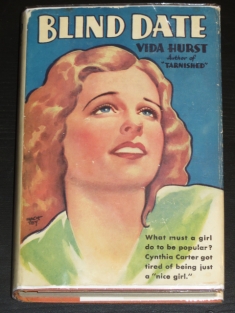 “What must a girl do to be popular?”
“What must a girl do to be popular?”
Cynthia Carter couldn’t get a date to her town’s Valentine’s dance and has just been stood up in the worst way. A blind date scuttled off after pretending to be called away, only everyone could see he had been holding down the receiver on the landline. What happens next makes up the plot of Blind Date by Vida Hurst, published in 1931 with dust jacket art by Mach Tey.
This is the second Vida Hurst book to be covered on this blog, the first being No Such Girl. Like No Such Girl, Blind Date features an incredibly naive young protagonist making groan-inducing choices, and is set away from the east coast. No Such Girl is set in Michigan, and Blind Date is set in Missouri. How many other 1930s romance novels are set in Kansas City, Missouri? After having recently visited there for a literary-themed wedding, I think Kansas City is a great choice for a romance novel.
Our three main suitors are Kenton Field, Roddy Nelson, and Houston Harrison. Kenton is the boy next door, Roddy is the date-dodger and Houston is the family friend. Of the three suitors, Cynthia can’t get rid of Houston quickly enough. She describes him as, “the sort who, after knowing a girl for years, would ask permission to hold her hand” and scoffs at his beautiful “feminine” handwriting. The turning point with Houston is when Cynthia turns him down for an evening out, and then, upon being asked to go, Cynthia’s older sister turns him down too. Considered an old maid in her late twenties(!), Hollis stands up for herself and refuses to be “second choice.” Houston is then stuck going with the sisters’ MOM. After learning that Cynthia isn’t interested and Hollis doesn’t want to be second choice, Houston changes his tactics and before the novel ends he and Hollis are married and expecting a baby. Maybe Cynthia was wrong in her previous estimation of Houston.
Houston wouldn’t be the only character Cynthia misjudges. After her friends dismiss Roddy following his landline stunt, Cynthia continues to pine away for another two hundred pages. Deciding she would like to be the sort to impress men, our protagonist embarks on a self-improvement mission.
In Cynthia’s quest for fashion greatness, Blind Date has a subplot I hadn’t read before in a 1930s romance: a cautionary tale about store credit charges. Cynthia opens a line of credit and immediately charges $434.95 in clothing purchases. If that sounds like a lot, take inflation into consideration too. According to one inflation calculator, that would be about $6,890 today! Her inability to pay this off makes her creditor’s escalation a driving force of the plot. She finds out what it means to have her credit ruined in town at other stores, and almost loses her job. After having learned hard lessons about buying clothing out of her price range, Cynthia takes out a high interest loan and makes good on her debt. She also decides to wear only black, white, blue, and pink, for whatever that’s worth.
Despite limiting herself to four clothing colors and getting into debt, the most cringe-worthy choices Cynthia makes are about Roddy Nelson. He’s jealous and sleazy throughout the novel. He lies about being engaged to another woman and just about everything else. Cynthia’s infatuation with him ends in a change of heart, and she instead ends up with the boy next door who had been listening to her problems for the length of the novel. Just to drive the point about fashion home, Cynthia is wearing a dark plain flannel bathrobe (color not specified!) for her happy ending with Kenton.
Blind Date was made into a 1934 movie by the same name, starring Ann Sothern, Neil Hamilton, and Paul Kelly.
 Copies of Vida Hurst’s works are available for purchase here including Blind Date.
Copies of Vida Hurst’s works are available for purchase here including Blind Date.


Wow, I am finding her palette choice to be fascinating for 1930something. This book certainly does mine some unusual territory. I love the financial lesson as well as smelling the flowers in the bouquet on hand. I guess the East and West Coast gals just never enjoyed the whirlwind thrill of confused love complications. Thanks for another episode of undiscovered gems for those of us who never considered love in the time of the 1930’s. Read on and keep reporting.
Pingback: This Woman Just Won A Prize For Book Collecting, And Now You Have New Goals In Life
Pingback: This Woman Just Won A Prize For Book Collecting, And Now You Have New Goals In Life – AboNewsCast
Pingback: This Woman Just Won A Prize For Book Collecting, And Now You Have New Goals In Life – SelfHelpEA
I love the cover and the practical lesson of the story! The Vida Hurst above I really want to find is Glittering Sham, since the cover is gorgeous and the plot takes place in Hollywood. There’s a special place in my heart for a 30s Hollywood novel!
Glittering Sham is out there available for sale! I snagged my copy (which admittedly isn’t the sharpest) about six years ago. I’ve only read two Vida Hurst books so far, but have about eight or so. According to the dust jacket of Marriage a la Mode, Vida Hurst worked as an extra in Hollywood.
Pingback: Party Girl | thegoodbadbook